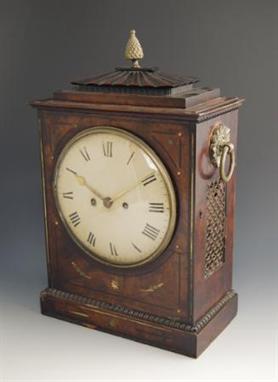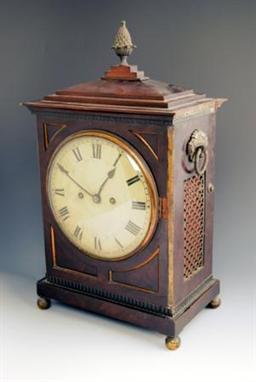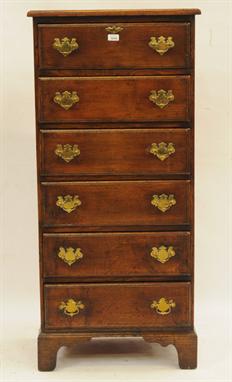James McCabe. An ebonised striking bracket clock, the restored painted dial signed James McCabe, Royal Exchange, London, the arch containing strike/silent, two-train chain fusee movement fully signed on the back plate and numbered 6721 within oval, engraved borders, in a break arch case with gilt fish scale grills, ball feet and carrying handle, c. 1800, 17in (43cm) h.
We found 177913 price guide item(s) matching your search
There are 177913 lots that match your search criteria. Subscribe now to get instant access to the full price guide service.
Click here to subscribe- List
- Grid
-
177913 item(s)/page
John Cotsworth, London. A very rare marquetry quarter repeating bracket clock, 8 inch square brass dial with silvered chapter ring, matted centre with calendar aperture, ringed winding holes and signed John Cotsworth, London, within the mock pendulum aperture, Strike/Not lever above 12 o`clock, the movement with verge escapement, pull quarter repeating on 6 bells, the backplate signed John Cotsworth, London amongst profuse foliate engraving, wheatear engraved border, the case superbly veneered with all over arabesque geometrical and pictorial marquetry designs including the inner surfaces of both doors, the basket top now replaced with matching veneered inverted bell top, on brass bun feet with urn finials and scrolled carrying handle, circa 1700, 16.5in (42cm) h. Literature: Antiquarian Horology Vol 31 no. 4 (June 2009). "English Marquetry Table Clocks" by Robert Donaldson illustrates other clocks with similar decoration including an example by John Cotsworth.
An ebonised and gilt brass mounted bracket clock, with a twin fusee movement striking on a bell, the backplate numbered 857, with a 5.5inch square brass dial having a silvered chapter ring with subsidiary Strike/Silent and regulation dials, the centre floral engraved and signed A. Hewlet, Bristol, with a pendulum bob aperture above, the case with an architectural pediment and raised cast leaf feet, 13.25in (33.5cm) h.
A quarter chiming ebonised mantel clock, arched brass dial with twin subsidiaries for Chime/Silent and Slow/Fast, a plaque in the centre painted DENT, substantial 3 train fusee movement chiming on 8 bells and striking on a gong, in a break arch case flanked by gilt brass caryatids and applied with various mounts, 24in (61cm) h, with bracket. (2)
An 18th century French boulle bracket clock, square plated movement signed Le Mayre a Paris, gilt dial embossed with musical instruments, blue and white numeral reserves, set with a plaque below signed Pecquet a Paris, in a tapering case applied with ormolu mounts cherub finial, 31in (84cm) h.
An 8 day mahogany longcase clock, quarter striking on two bells with a 14 inch painted arch dial with subsidiary seconds dial and pierced crescent date aperture, signed Ifaac Court HENLEY, with a painted fly between IIII and V, the arch painted a rondel of Father Time, the hood with stop fluted columns with gilt brass corinthian capitols, the trunk door crossbanded and with chevron stringing, canted corners to a marquetry base on ogee bracket feet, 88.5in (225cm) h.
Vulliamy, London, No. 913. A small rosewood mantel timepiece, the dial with royal monogram, single-train fusee movement with anchor escapement, signed and numbered on the back plate, with an arched silvered dial signed Vulliamy London at 12 o`clock, pendulum rise and fall adjustment within the XII numeral, blued steel spade handles, the lower dial section engraved with the monogram of King George IV with the inscription "Commander in Chief," in a chamfer top case with silvered sight ring, reeded band and brass inlaid canted corners and base, raised on adjustable brass acorn feet, 8in (20.5cm) high. No.913 is recorded in the Vulliamy records as `Small Spring time piece in rose wood case for the Horse Guards`. The movement supplied by Holmden and lists various workers for the case, engraving, a bracket shelf (now missing), silvering and examining. The timepiece was `Sent to the Horseguards by order of Col Stephenson July 16th 1826`. The Commander in Chief in 1826 was Field Marshall Prince Frederick, Duke of York. The Duke of Wellington took over the following year, 1827. It is possible that the clock may have been a leaving present to the Duke of York from the Horse Guards staff. We are most grateful to the British Horological Institute for their assistance in cataloguing this lot.
19th Century mahogany Longcase Clock, the hood with an architectural pediment above a gilt glass frieze, turned supports, long door with three-quarter columns, on ogee bracket feet, square brass dial, with cast spandrels, silvered chapter ring, with Roman numerals, inscribed, Jno. Yates, Liverpool, subsidiary seconds dial and date aperture, eight-day movement, striking on a bell, 230cms, (7`6").
Late 18th Century Longcase Clock, the painted square dial inscribed, "Deacon Barton", with secondary date dial, painted with an exotic pheasant and fruits and flowers in the spandrels, thirty-hour movement, contained within an oak inlaid case, with break-arch pediment, with dentil cornice, the hood with inverted turned columns, crossbanded door with central inlay and bracket feet, 214cms, (7`).
A George III oak bureau cabinet, the top fitted two panelled doors with candle slides below, opens to reveal fitted shelves, over base with writing fall opening to reveal fitted interior of pigeon holes and drawers about a central cupboard, flanked by concealed storage, retractable columns, base fitted two short over two long drawers, on bracket feet, 93cm (36 1/2in) wide
-
177913 item(s)/page


















































